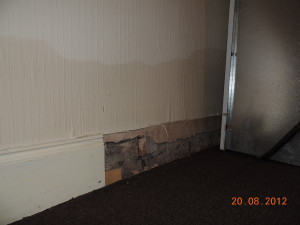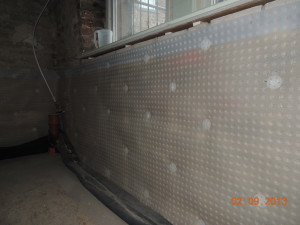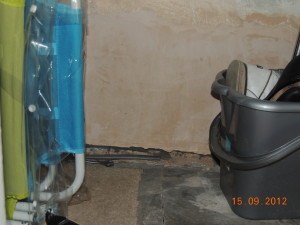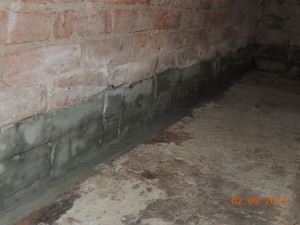
Rising damp results in unsightly damage to internal decorations, which will lead to timber decay and heat loss through the wall. In addition rising moisture from the ground, carries with it hygroscopic ground salts such as chlorides and nitrates. Which have the natural ability to absorb moisture from the atmosphere leading to the wall becoming damp in conditions of high relative humidity. The cyclical nature of the crystallisation and rewetting of these salts breaks down internal plaster and ruin internal decorations, this is the reason why the plaster needs to be removed and replaced.
How do we cure the rising dampness?
First and most important is the survey, this is undertaken by one of our qualified surveyors. This is to ensure that the defects are due to rising dampness and not some other defect, installing a damp proof course will not cure moisture defects, due to lateral movement of moisture due to a high external ground or neighbours floor levels.
The surveyor will write a detailed report and specification for the remedial works required, to BS6576:2005+A1:2012 ‘Code of Practice for the Installation of Chemical Damp-proof Courses’ ensuring that your problem is cured and also guaranteed, with a fully insured GPI independent insurance.
General treatment methods
As a result of rising damp salts are deposited on the plaster surface, these salts are hygroscopic and have a natural ability to absorb moisture from the air. This can give the impression that rising damp persists after a DPC has been installed. The renewal of the affected plaster to our specification of affected plaster is an integral part of the overall treatment.
Plaster renewal must be a minimum of one meter or 300mm above the last visible signs of dampness or one metre above the proposed line of the DPC, whichever is the higher. The Agreement Board and B.S.I. advise that the D.P.C. contractor carries out both operations, to avoid having split responsibility for the D.P.C. installation and replastering.
Replastering can be undertaken using different methods and materials as detailed within BS 6576: 2005+A1:2012.
A hard render applied to the wall surface which will incorporate water proofer, and salt inhibitor, to prevent the lateral movement of moisture and hygroscopic salt leeching through to the decorative finish.
 Renovating plaster this is a lighter lime based plastering system which allows the property to breath, and dry down naturally, the down side to this system is that the surface can be affected by efflorescent salting as the moisture held within the structure evaporates. Plaster membrane systems are a studded polypropylene waterproofing membrane with a special mesh welded to one side. It is fixed to damp, contaminated walls using Plaster Plugs, with the studs facing the wall. This creates an air-gap which allows the wall to breathe whilst blocking the passage of moisture. On the reverse side of the membrane, the special mesh can be plastered onto, allowing a dry plaster finish to be achieved without the risk of contamination from any damp or salts in the wall.
Renovating plaster this is a lighter lime based plastering system which allows the property to breath, and dry down naturally, the down side to this system is that the surface can be affected by efflorescent salting as the moisture held within the structure evaporates. Plaster membrane systems are a studded polypropylene waterproofing membrane with a special mesh welded to one side. It is fixed to damp, contaminated walls using Plaster Plugs, with the studs facing the wall. This creates an air-gap which allows the wall to breathe whilst blocking the passage of moisture. On the reverse side of the membrane, the special mesh can be plastered onto, allowing a dry plaster finish to be achieved without the risk of contamination from any damp or salts in the wall.
Thermal lining boards board can be installed to the exposed elevations, this reduces the heat loss through the structure, prevents the lateral movement of moisture and hygroscopic salts into the decorative finish as well as providing a stable plastering system. If you have any questions please call us on 0161 633 9860 and we will be happy to answer any of your questions or make arrangements to undertaken an inspection, to ensure your property is structurally is both sound and dry.
PLASTER – IN CONJUNCTION WITH DPC INSTALLATION
Chemical type damp proofing Chemical damp-proof courses are installed in walls by various methods depending on the particular system being employed, but the ultimate objective is to provide a water repellent or pore blocking material in a continuous horizontal band in the masonry, thereby to provide a ‘barrier’ to water rising from the ground.
It is a fact that the only continuous pathways through which water can rise through a masonry wall are the mortar beds, it is therefore essential that the damp-proofing material installed impregnates the mortar courses since this forms the pathway for the rise of water within walls. Damp-proofing into the bricks will not be anything like as effective.
 Floor to wall joint
Floor to wall joint
In older properties where the walls affected by rising dampness abut up to a solid floor then a floor to wall joint must be installed, to prevent moisture evaporating out from under the floor slab.
This image shows a typical scenario where the damp proof course failed due to the floor to wall joint being omitted, resulting in the plaster bridging the DPC and the skirting board being affected by fungal decay, due to moisture evaporating from below the installed damp proof course and solid floor void.
 In the image to right is area an area of wall striped of plaster which abuts a solid floor, with the floor to wall joint installed, so linking the floor and wall areas. The system has been extended above the plastering line, so to prevent any possible bridging of the installed damp proof course by plaster. BS 6576 : section 6.1.5.
In the image to right is area an area of wall striped of plaster which abuts a solid floor, with the floor to wall joint installed, so linking the floor and wall areas. The system has been extended above the plastering line, so to prevent any possible bridging of the installed damp proof course by plaster. BS 6576 : section 6.1.5.
Olympic Construction are Property Care Association Members
Property remedial treatments and surveys in Oldham, Manchester, Rochdale, Stockport, Cheshire and throughout the North West. For advice or to arrange a survey, give us a call today!
Damp Proofing, Rising Damp services in Oldham, Manchester, Rochdale, Stockport & Cheshire.


